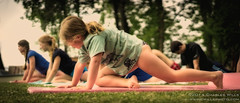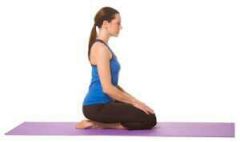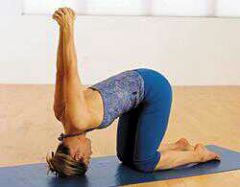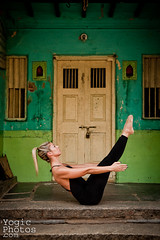![]()
![]()
![]()
Use LEFT and RIGHT arrow keys to navigate between flashcards;
Use UP and DOWN arrow keys to flip the card;
H to show hint;
A reads text to speech;
189 Cards in this Set
- Front
- Back
|
Hatha translation |
ha meaning 'sun'
Hatha-yoga The way towards realisation through rigorous discipline. |
|
|
Kona
|
Angle
|
|
|
Pada |
Foot or Leg |
|
|
Utthita |
Extendedl Raised up, extended, stretched. |
|
|
Ardha |
Half |
|
|
Baddha |
Bound |
|
|
Kapota |
Pigeon |
|
|
Pratyahara
|
Draw the senses inward, relieving them of their external distractions. |
|
|
Yoga
|
Union, communion. |
|
|
uttana |
intense stretch |
|
|
Bandha |
Bondage or fetter. It means a posture where certain organs or parts of the body are contracted and controlled. |
|
|
utkata |
powerful, fierce |
|
|
ut |
intense; A particle, denoting intensity. |
|
|
Bharadvajasana
|
Bharadvaja's twist |
|
|
Eka |
One |
|
|
anga |
limb |
|
|
Mukha |
Face |
|
|
janu |
knee |
|
|
Dhanura
|
bow |
|
|
parigha
|
a bar used for locking a gate |
|
|
Hasta |
The hand. |
|
|
Matsyendrasana
|
lord of the fishes |
|
|
Aum |
Like the Latin word 'Omne', the Sanskrit word 'Aum' means 'all' and conveys concepts of 'Omniscience', 'Omnipresence' and 'Omnipotence'. |
|
|
Supta |
Reclining |
|
|
Svana |
Dog |
|
|
Dhyana |
Meditation |
|
|
Samadhi
|
Bliss, absorption |
|
|
tan |
stretch or extend |
|
|
Jnana |
Sacred knowledge derived from meditation on the higher truths of religion and philosophy, which teaches a man how to understand his own nature. |
|
|
setu |
bridge |
|
|
Janu
|
The knee. |
|
|
Chatur |
The number four. |
|
|
pashima |
west |
|
|
marjari |
cat |
|
|
Purva
|
East, the front of the body. |
|
|
Dristana
|
Conscious gazing |
|
|
Mandala
|
A circle. |
|
|
vira |
man, hero |
|
|
Asana
|
"To take one seat" |
|
|
Adho |
Head |
|
|
Chakra
|
Literally, a wheel or circle. Energy (prana) is said to flow in the human body through three main channels (nadis), namely, Susumna, Pingala and Ida. Susumna is situated inside the spinal column. Pingala and Ida start respectively from the right and left nostrils, move up to the crown of the head and course downwards to the base of the spine. These two nadis intersect with each other and also the Susumna. These junctions of the nadis are known as chakras or the fly-wheels which regulate the body mechanism. ChandraThe moon. |
|
|
Pranayama |
Rhythmic control of the breath. The fourth stage of yoga. |
|
|
Prana |
Breath, respiration, life, vitality, wind, energy, strength. It also connotes the soul. |
|
|
Purvottana
|
The intense stretch of the front side of the body. |
|
|
Pratyahara |
Sense withdrawal |
|
|
sarva |
all |
|
|
Chitta |
The mind in its total or collective sense, being composed of three categories: (a) Mind, having the faculty of attention, selection and rejection; (b) Reason, the decisive state which determines the distinction between things and (c) Ego, the I-maker. |
|
|
sirsa |
head |
|
|
Adho-mukha |
Face downwards. |
|
|
ustra |
camel |
|
|
Kriya
|
An expiatory rite, a cleaning process. |
|
|
Mala
|
A garland, wreath. |
|
|
Prasarita |
Spread out, stretched out. |
|
|
Kundalini
|
The Kundalini (kundala=coil of a rope; Kundalini=a coiled female serpent) is the divine cosmic energy. This force or energy is symbolised as a coiled and sleeping serpent lying dormant in the lowest nerve centre at the base of the spinal column, the Muladhara-chakra. This latent energy has to be aroused and made to ascend the main spinal channel, the Susumna piercing the chakras right up to the Sahasrara, the thousand-petalled lotus in the head. Then the Yogi is in union with the Supreme Universal Soul. |
|
|
Pratyahara |
Withdrawal and emancipation of the mind from the domination of the senses and sensual objects. The fifth stage of yoga. |
|
|
Karna Pidasana |
Pressure on ears pose. |
|
|
Nava
|
A boat. |
|
|
Chandrasana |
Moon |
|
|
Dwi-hasta
|
Two hands. |
|
|
Raja |
King |
|
|
Patanjali
|
The author of the yoga sutras. The propounder of Astanga yoga. He put it on paper, so the world could experience it. |
|
|
Mantra |
A sacred thought or a prayer. |
|
|
Dwi-pada |
Two feet or legs. |
|
|
Sarva
|
All, whole. |
|
|
Nirodha
|
Restraint, suppression. |
|
|
Padma |
A lotus. |
|
|
Bakasana |
Elbow balancing pose |
|
|
Paschimottanasana |
Seated forward bend. |
|
|
Tha
|
The second syllable of the word 'hatha'. The first syllable 'ha' stands for the sun, while the second syllable 'tha' stands for the moon. The union of these two is Hatha-yoga. |
|
|
Asana Posture |
The third stage of yoga. |
|
|
San
|
Six. |
|
|
Bhakti
|
Worship, adoration. |
|
|
Niyama |
Self-purification by discipline. The second stage of yoga mentioned by Patanjali. |
|
|
Hala |
Plow |
|
|
Go |
Cow |
|
|
Pasa |
A fetter, trap, noose. |
|
|
Niyama |
Observances |
|
|
Prajna |
Intelligence, wisdom. |
|
|
Vritta
|
Fluctuation. |
|
|
Guru |
Spiritual preceptor, one who illumines the darkness of spiritual doubt. |
|
|
Purva
|
- the front of the body |
|
|
Apana |
One of the vital airs which move in the sphere of the lower abdomen. |
|
|
Salamba |
With support. |
|
|
Anga |
The body; a limb or a part of the body; a constituent part. |
|
|
Dharana |
Focused Concentration
|
|
|
Urdhva |
Raised, elevated, tending upwards. |
|
|
Upavistha
|
Seated. |
|
|
Karma-yoga
|
The achievement of union with the Supreme Universal Soul through action. |
|
|
Ru
|
The second syllable in the word 'guru', meaning light. |
|
|
Raja-yoga |
The achievement of union with the Supreme Universal Spirit, by becoming the ruler of one's own mind by defeating its enemies. |
|
|
Karma
|
Action. |
|
|
Paripurna |
Entire, complete. |
|
|
Vasistha |
A celebrated sage, author of several Vedic hymns. |
|
|
Purvottanasana
|

Upward Plank Pose
Pose of the intense stretch of the front side of the body. |
|
|
Ujjayi
|
A type of pranayama in which the lungs are fully expanded and the chest is puffed out. |
|
|
Yogi or Yogini |
One who follows the path of yoga. |
|
|
Sarvanga |
The whole body. |
|
|
Astanga Yoga |
The eight limbs of Yoga described by Patanjali. |
|
|
Dhyana Meditation |
The seventh stage of Yoga mentioned by Patanjali. |
|
|
Yoga-mudra
|
A posture. |
|
|
Bhuja
|
The arm or the shoulder. |
|
|
Pida |
Pain, suffering, pressure. |
|
|
Tola |
A balance. |
|
|
Karna Pidasana
|

Pressure on ears pose
|
|
|
danda |
staff |
|
|
Ayurveda |
The traditional Hindu system of medicine, which is based on the idea of balance in bodily systems and uses diet, herbal treatment, and yogic breathing. |
|
|
Gu
|
First syllable in the word 'Guru', meaning darkness. |
|
|
Karna
|
The ear; also one of the heros in the Mahabharata. |
|
|
Parivrtta
|
revolved or twisted |
|
|
Tapas
|
Burning away impurities through self-discipline. |
|
|
Asta |
The number eight. |
|
|
Yama |
Restraints |
|
|
Paschima
|
- The West; the back of the body |
|
|
Paschimottana
|
Intense stretch of the back side of the body from the nape to the heels. |
|
|
Siddha
|
A sage, seer or prophet; also a semi-divine being of great purity and holiness. |
|
|
Pada Bandha
|
Engagement of the feet, locking
|
|
|
Supta |
Sleeping. |
|
|
Parsva
|
Side-, Flank-, pertaining to rib area. |
|
|
hanuman
|
monkey |
|
|
Bhuja-pida |
Pressure on the arm or shoulder. |
|
|
Namaste
|
Commonly said at the end of yoga class by the instructor and the students. |
|
|
Samadhi
|
Deep Absorption |
|
|
Utthita Tadasana |

Five Pointed Star |
|
|
Bakasana
|

Crow Pose |
|
|
Baddha Konasana
(BAH-dah-cone-AHS-anna) |

Bound Angle |
|
|
Dhanurasana
(don-your-AHS-anna) |

Bow Pose
Dhanu - bow |
|
|
Setu Bhandasana
(set-too bahn-DAHS-anna) |

Bridge Pose
Setu Bandha - forming of causeway or bridge |
|
|
Ustrasana |

Camel Pose |
|
|
Balasana |
Child Pose |
|
|
Garbhasana
(gar-BAHS-anna) |

Foetus Pose
Garbha - born from a womb |
|
|
Bhujangasana
(boo-jang-GAHS-anna) |

Cobra Pose
Bhujaga - a serpent, moving in curves |
|
|
Shavasana
(shah-VAHS-anna) |

Corpse Pose
Sava - corpse, support |
|
|
Balakikasana
(BALA-kik-AHS-anna) |

Crane Pose
Balakika - a species of small crane |
|
|
Adho Mukha Svanasana
(Ah-doh-MOO-kah-shvah-NAHS-anna) |

Downward Facing Dog
Adho Mukha - having the muzzle downward Svan - dog |
|
|
Gomukhasana
(go-MOO-KAHS-anna) |

Face of Light |
|
|
Matsyasana
(mot-see-AHS-anna) |

Fish Pose
Matsya - a fish |
|
|
Chatarunga Dandasana
(chaht-tour-ANG-ah don-DAHS-anna) |

Four Limb Staff Pose
Chatur - four anga-limb Danda - staff |
|
|
Parighasana
(par-ee-GOSS-anna) |

Gate Pose |
|
|
Maha Mudra
(mah-hah MOO-drah) |

Great Seal Pose |
|
|
Ardha Salabhasana
(ARE-dah sha-la-BAHS-anna) |

Half Locust Pose
Ardha - half Salabha - a grasshopper, locust 1. Lie on your belly, with the chin on the floor, legs together and arms alongside the body, with the palms down. 2. Rock the hips from side to side to walk the arms underneath your body, so that the forearms are on the inside of the hip bones and the hands are under the thighs. 3. Inhale and lengthen the legs, reaching the toes away from your body. Pull up the knee caps, squeeze the buttocks and engage mula bandha. Press the arms down into the floor and slowly lift the legs up towards the ceiling. 4. Breathe and hold for 2-5 breaths. 5. To release: exhale and slowly lower the legs to the floor. Turn the head to one side, slide the arms out from under your body and rest. BENEFITS + CONTRAINDICATIONS Benefits: Half Locust pose strongly strengthens the core body and the low back muscles. Locust stimulates the endocrine, nervous and reproductive systems. Contraindictions: Recent or chronic injury to the back or legs, pregnancy and recent abdominal surgery. MODIFICATIONS + VARIATIONS Modifications: Place a folded blanket under the hips or place a rolled up blanket or bolster under the thighs. Variations: A) Make fists with the hands. B) Bring the arms palms down next to the sides of your body. |
|
|
Ardha Chandrasana
(ARE-dah-chan-DRAHS-anna) |

Half Moon Pose
Ardha - half Chandra - the moon |
|
|
Ardha Sarvangasana
(ARE-dah-sar-van-GAHS-anna) Ardha - half Sarva - whole, entire Anga - limb |

Half Shoulderstand |
|
|
Sirsasana (shear-SHAHS-anna)
Sirsha - the head |

Headstand |
|
|
Parsvakonasana
(parsh-vah-cone-AHS-anna) Parsva - side, flank Kona - angle |

Side Angle OR Lateral Angle
Begin in Warrior 2, right foot in front 1. Bring right forearm to right knee 2. Slide back heel away to bring front thigh toward parallel to ground. 3. Draw left shoulder back 4. Elongate spine by drawing sacrum towards left heel and press out through crown. 5. Extend left arm in line with back leg TO RELEASE 1. Return torso and arms to warrior 2 2. Repeat on opposite side. |
|
|
Tadasana
(tah-DAHS-anna) |

Mountain Pose
Tada - a mountain |
|
|
Kapotasana
(cop-poh-TAHS-anna) Hint: bird |

Pigeon
Kapota - a dove, pigeon |
|
|
Phalakasana |

Plank Pose |
|
|
Pashchimottanasana (POSH-ee-moh-tan-AHS-anna)
Paschima -the west Uttama - uppermost, best |

Side Plank |
|
|
Yama
|
The god of death. Yama ia also the first of the eight limbs or means of attaining yoga. |
|
|
Matsyendrasana (MOT-see-en-DRAHS-anna)
Matsyendra - teacher of yoga |

Spinal Twist |
|
|
Dandasana
|

Staff Pose |
|
|
Supta Vajrasana |

Fixed Firm Pose |
|
|
Uttanasana (OOT-tan-AHS-ahna)
Ut - intense Tan- to stretch or extend |

Standing Forward Bend |
|
|
Pratapana |
Warming, heating, to put near fire
|
|
|
Padahastasana
(pad-ah-hastanana) |

Hand-under-foot posture
|
|
|
Vajrasana
|

Thunderbolt Pose
|
|
|
Dharana
|
Focused concentration |
|
|
Utkatasana
|
Standing Squat OR Chair Pose |
|
|
Utthita Hasta Padangusthasana
|

Extended hand-to-big-toe posture (standing on one leg with the raised foot kicked out at chest- or head-height, gripping the big toe with the hand that's on the same side) |
|
|
Prasarita Padottanasana
( pra-sa-REE-tah pah-doh-tahn-AHS-anna) Prasarita - stretched out, spread Pada- foot |

Wide Legged Forward Bend OR Standing Wide Angle |
|
|
Supta Matsyendrasana
(SOUP-tah MOT-see-en-DRAHS-anna) Supta - supine Matsyendra - a sage of yoga |

Supine Twist
|
|
|
Yoga Mudra
(yo-gah MOO-drah) |

Symbol of Yoga
Begin in Vajrasana 1. Raise arms out in front parallel to ground 2. Sweep hands behind back interlacing fingers 3. Hinge forward at hips bringing head to ground 4. Lift arms behind back and press hands up toward sky. 5. Roll onto top of head lifting hips over knees 6. Continue to move arms away from back TO RELEASE 1. Return sitz bones to heels 2. Lift torso upright, releasing arms |
|
|
Padangusthasana
(pa-dan-GOOS-tha-sana) |

|
|
|
Vrksasana
(vrik-SHAHS-anna) |

Tree Pose
Vrka - the trunk of tree |
|
|
Trikonasana
(trik-cone-AHS-anna) |

Triangle Pose |
|
|
Parsvottanasana
(parsh-voh-tahn-AHS-anna) |

Intense Side Stretch
parsva = side, flank ut = intense tan = to stretch or extend (compare the Latin verb tendere, to stretch or extend) Step by Step Stand in Tadasana . With an exhalation, step or lightly jump your feet 3½ to 4 feet apart. Rest your hands on your hips. Turn your left foot in 45 to 60 degrees to the right and your right foot out to the right 90 degrees. Align the right heel with the left heel. Firm your thighs and turn your right thigh outward, so that the center of the right knee cap is in line with the center of the right ankle. Exhale and rotate your torso to the right, squaring the front of your pelvis as much as possible with the front edge of your mat. As the left hip point turns forward, press the head of the left femur back to ground the back heel. Press your outer thighs inward, as if squeezing a block between your thighs. Firm your scapulas against your back torso, lengthen your coccyx toward the floor, and arch your upper torso back slightly. With another exhalation, lean the torso forward from the groins over the right leg. Stop when the torso is parallel to the floor. Press your fingertips to the floor on either side of the right foot. If it isnt possible for you to touch the floor, support your hands on a pair of blocks or the seat of a folding chair. Press the thighs back and lengthen the torso forward, lifting through the top of the sternum. In this pose the front-leg hip tends to lift up toward the shoulder and swing out to the side, which shortens the front-leg side. Be sure to soften the front-leg hip toward the earth and away from the same-side shoulder while you continue squeezing the outer thighs. Press the base of the big toe and the inner heel of the front foot firmly into the floor, then lift the inner groin of the front leg deep into the pelvis. Hold your torso and head parallel to the floor for a few breaths. Then, if you have the flexibility, bring the front torso closer to the top of the thigh, but dont round forward from the waist to do this. Eventually the long front torso will rest down on the thigh. Hold your maximum position for 15 to 30 seconds, then come up with an inhalation by pressing actively through the back heel and dragging the coccyx first down and then into the pelvis. Then go to the left side. |
|
|
Paripurna Navasana
(par-ee-POUR-nah-VAHS-anna) |

Upward Boat
Paripurna - completely filled Nava - boat |
|
|
Urdhva Mukha Svanasana
(OORD-vah MOO-kah-shvon-AHS-anna) |

Upward Facing Dog
Urdhva - upward Mukha - facing Svama - Dog |
|
|
Virabhadrasana Eka (veer-ah-bah-DRAHS-anna eka)
Vira - bravery, courage Bhadra - blessed, auspicious |

Warrior 1 |
|
|
Virabhadrasana Dwi (veer-ah-bah-DRAHS-anna-dwee)
Vira - bravery, courage Bhadra - blessed, auspicious |

Warrior 2 |
|
|
Upavistha Konasana (oo-pah-VEESH-tah cone-AHS-anna)
Upavista - seated, sitting Kona - angle |

Wide Angle Forward Bend |
|
|
Pranayama |
the regulation of the breath through certain techniques and exercises. |
|
|
Standing Postures |
Best performed early because they require strength, stamina, and upper legs (largest muscles in body). Increase mental alertness and helps students feel more grounded. |
|
|
Balancing Postures |
Best done towards end of standing sequence once student feels grounded / stable. Balance poses act to create balance or reflect the current state of balance in both the mental and physical bodies. Asymmetrical movements most common. They point out strengths / weaknesses and allow opp to balance out weaknesses. Guide students to work on their weaker side 1st then 3rd, and the stronger side only once. |
|
|
Lateral Bends |
Best explored after the spine has warmed up. Elongates the ribs and warm the tissue of the torso.
Support elongation in the backbends and help to stimulate the abdominals. |
|
|
Backbends |
Done at the high point of class, and require the most amount of physical preparation. Shoulders, low back, quads, adductors, and pelvic floor must be sufficiently lengthened and warmed up.
Bc deep backbends create heat and stimulate the nervous system there needs to be sufficient time to cool down. |
|
|
Forward Bends |
Excellent to incorporate in the cool down phase of practice bc they are cooling, quieting and help generate introversion.
* Provide a counter stretch for the opening in back extensions. |
|
|
Twists
|
Neutralizing postures, twists will calm the body if agitated and stimulate it if it is dull or lethargic. They help bring the nervous system and glandular system into balance. If done after backbends they are cooling and soothing. Stimulating if done after Forward Bends. |
|
|
Inversions |
Best performed after shoulder openers such as bridge and shoulder strengtheners such as downward dog. Explore Headstand before Shoulderstand as a heated inversion while Shoulderstand is cooling and provides a counter stretch to the neck muscles. |
|
|
The 7 means for perfecting oneself on the yogic path
|
Shatkarmas for purification ;asana for strength ;madras for steadiness; pratyahara for calmness; pranamaya for lightness; dhyana for realization ; and samadhi for bliss
|
|
|
3 purposes of Hatha yoga
|
1. The total purification of the body 2. The complete balancing of the physical, mental, and energetic fields 3. The awakening of pure consciousness through which one ultimately connects with the divine by engaging in practices rooted in the physical body |
|
|
Shatkarma- purification process |
shat meaning 6 |
|
|
What are Sthira and Sukha? |
Sthira = steadiness and alertness Sukha = The ability to remain comfortable in a posture
*without the both of these you do not have a proper asana |
|
|
What is the 1st step of our yoga practice? |
To connect breath and body. *The correct linkage of breath and body is the basis for our entire asana practice. It is the most important aspect of practice. |
|
|
What are the rules for connecting breath to movement? When do we breathe? |
When we contract the body we EXHALE, when we expand the body we INHALE. *Breathing initiates the movement. |
|
|
________ at the end of each movement helps us remain conscious of both the ______ and the ______. |
Pausing at the end of each movement helps us remain conscious of both the movement and the breath.
*Losing attention causes our practice to become mechanical, then we are not doing yoga. |
|
|
Why do we first expand the chest and then the abdomen when breathing during practice? |
It stretches the spine and helps to straighten the back. When we breathe in to the abdomen first, and then the chest, the abdomen expands so much that it inhibits the expansion of the chest and consequently the spine is not extended enough. Also the organs are then pressed down rather than the diaphragm being given room to move freely by the rising action of the chest. |
|
|
What is Ujjayi? |
A breathing technique that produces a fine, smooth feeling by narrowing the flow of breath in the throat. It allows us to hear as well as feel the breath as it become deeper and longer. |
|
|
Another way for invigorating and deepening our practice is to _______ the natural pause between the exhalation and inhalation, and between the inhalation and exhalation. |
Another way for invigorating and deepening our practice is to LENGTHEN the natural pause between the exhalation and inhalation, and between the inhalation and exhalation. |

